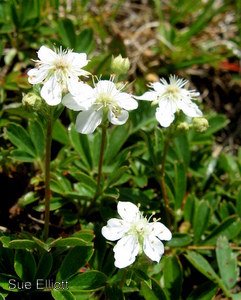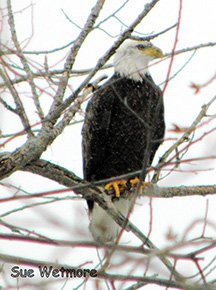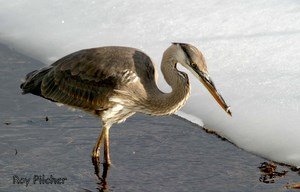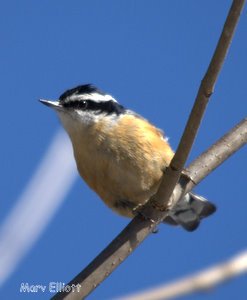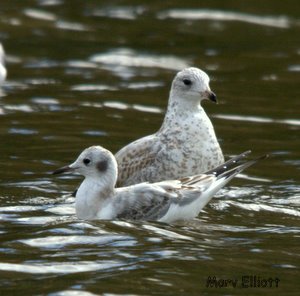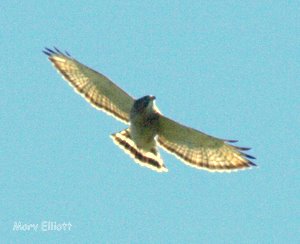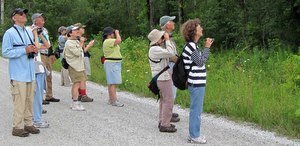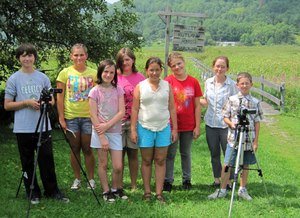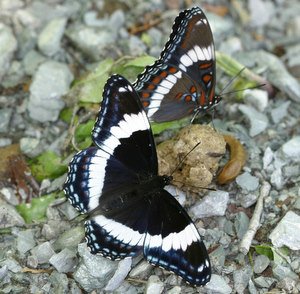 Verreaux's Eagle, an African birdRalph Handsaker (1886-1969) was an Iowa farmer, wood carver, carpenter, hunter, fisherman, taxidermist and oologist - egg collector. Carrol Henderson, the author of Oology, an ornithologist and avid nest collector (he has a species "nest list" of 500) became aware of Ralph Handsaker via his brother, who found out that an old farmhouse in Iowa, that belonged to the great-grandfather (Ralph Handsaker) of John Handsaker, was to be re-opened and restored for the grandson and his new wife. Thus, Ralph's egg collection, which had been in the farmhouse, neatly arranged in cabinets he had made, was rediscovered. The author was invited to survey the collection and see to its disposition.
Verreaux's Eagle, an African birdRalph Handsaker (1886-1969) was an Iowa farmer, wood carver, carpenter, hunter, fisherman, taxidermist and oologist - egg collector. Carrol Henderson, the author of Oology, an ornithologist and avid nest collector (he has a species "nest list" of 500) became aware of Ralph Handsaker via his brother, who found out that an old farmhouse in Iowa, that belonged to the great-grandfather (Ralph Handsaker) of John Handsaker, was to be re-opened and restored for the grandson and his new wife. Thus, Ralph's egg collection, which had been in the farmhouse, neatly arranged in cabinets he had made, was rediscovered. The author was invited to survey the collection and see to its disposition.
The heyday of oology was 1880-1918. It began as a hobby among bird enthusiasts in England in the mid to late 1800s, and then crossed the Atlantic to North America.
There were three main types of egg collectors. The market egger collected large numbers of wild bird eggs for commercial use and personal profit. Eggs were sold in markets and restaurants for human consumption. This was especially profitable near the seacoast where there were nests of gannets, auks, gulls, albatrosses, puffins, and murres. A notable example is Laysan Island, near Hawaii, which had large colonies of albatrosses. The albumen of their eggs was used to make albumen prints when exposures on glass plates were used in photo development.
A second group were young boys who collected eggs for fun. Most were destroyed, but for a few it led to a lifelong interest in wildlife, such as Franklin Delano Roosevelt.
Lastly, there were true oologists who collected and accumulated bird eggs using a standard protocol for preserving, identifying and labeling eggs and documenting nest data. Braving swamps, tall trees, dangerous seas and hostile natives, they were intrepid venturers. A few lost their lives in the quest. Ralph was quite determined. He devised a twelve-foot wooden ladder with a curved flat iron hook bolted to the top to hook over a tree limb. His collection consisted of 4,000 eggs. No laws protected birds, their nests or eggs in that era.
 Stanley Crane, another African birdMost oologists would collect the entire clutch because birds most often re-nest, though the second clutch usually had fewer eggs. Hundreds of eggs was not unusual for a good day of collecting. To lighten the load home, the oologist often blew out the egg in the field (this is necessary in any case for preservation). A small drill head was used to bore a hold in the egg. With a tiny blowpipe, a high pressure stream of air entering the holde forced the contents of the egg out.
Stanley Crane, another African birdMost oologists would collect the entire clutch because birds most often re-nest, though the second clutch usually had fewer eggs. Hundreds of eggs was not unusual for a good day of collecting. To lighten the load home, the oologist often blew out the egg in the field (this is necessary in any case for preservation). A small drill head was used to bore a hold in the egg. With a tiny blowpipe, a high pressure stream of air entering the holde forced the contents of the egg out.
As ink pen was then used to place data in a standard manner around the hole. The first number above the hole was the reference number of the American Ornithologist's Union for the species. The second number is written as a fraction. The top number was the "set mark" - the number of nests of that species collected on a particular day, under which was the number of eggs in that particular nest. Lastly, the date was recorded.
Eggs were stored in cabinets with drawers (sunlight would fade the colors), in cedar sawdust to keep insects away.
To supplement their collections, oologists often traded or purchased eggs. The author lists the 1904 value of Ralph's eggs. Most were less than $1, but the Great Auk egg could go for $1,600.
As early as 1831, in England, oology books had notable wild bird egg drawings. These, however, were not field books, but collectors' volumes of considerable value. Characteristic egg and nest paintings, many by famed bird artist Louis Agassiz Fuertes, were featured on bird trading cards, a popular premium in Arm and Hammer baking soda boxes. The author considers these cards to be America's first handy reference for identifying wild birds. Another type of publication was the 1904 "Taylor's Standard American Egg Catalogue," 98 pages of values for birds' nests and eggs. It served as a resource for trading and selling eggs, nets and stuffed birds. A typical ad is the following:
W. H. Bingham, Algoma, Iowa, Box 151: Collection of nests and eggs. Specialty - waders and warblers. Exchanges desired. Will purchase sets of above if reasonable. Must be from original collection.
Another section of the book covers egg classification. There are four basic egg shapes: ellipitical, pyriform, oval, and subelliptical. Since there are short, medium and long sub-categories, twlve different egg shapes are possible. The pigments, porphyrins, that create the colors, are prodcued by the breakdown of hemoglobin from ruptured blood cells, which are deposited on the egg as it traverses the oviduct and uterus. White eggs are found in species that nest in tree cavities or burrows where eggs are not visitble to predators. Patterns are classified as dotted, blotched, marble, overlaid, splashed, spotted, streaked or scrawled. There is great variation in markings that occurs within a single species and sometimes within a single clutch of eggs.
Egg collecting became illegal after the passage of the federal Migratory Bird Treaty Act of 1918.
After the background information on the history of egg collecting, Carrol Henderson spotlights sixty of the nearly 500 species present in the Handsaker collection. They were donated to the Peabody Museum of Natural History at Yale University in 2006.
These old collections are more than historical curiosities. The data they contain can reveal changes in species habitat, distribution, nesting sites and clutch size. Morphological measurement of egg size and shell thickness and chemical analysis of shells and their dried inner membranes can reveal the presence and effect of pesticides and heavy metals. DNA analysis is a burgeoning field of study.
Oology is fascinating reading. The numerous photographs, drawings and paintings are exquisite. The book is available through inter-library loan from the Rutland Free Library and, of course, from your local independent bookseller, and I presume, online resources.
